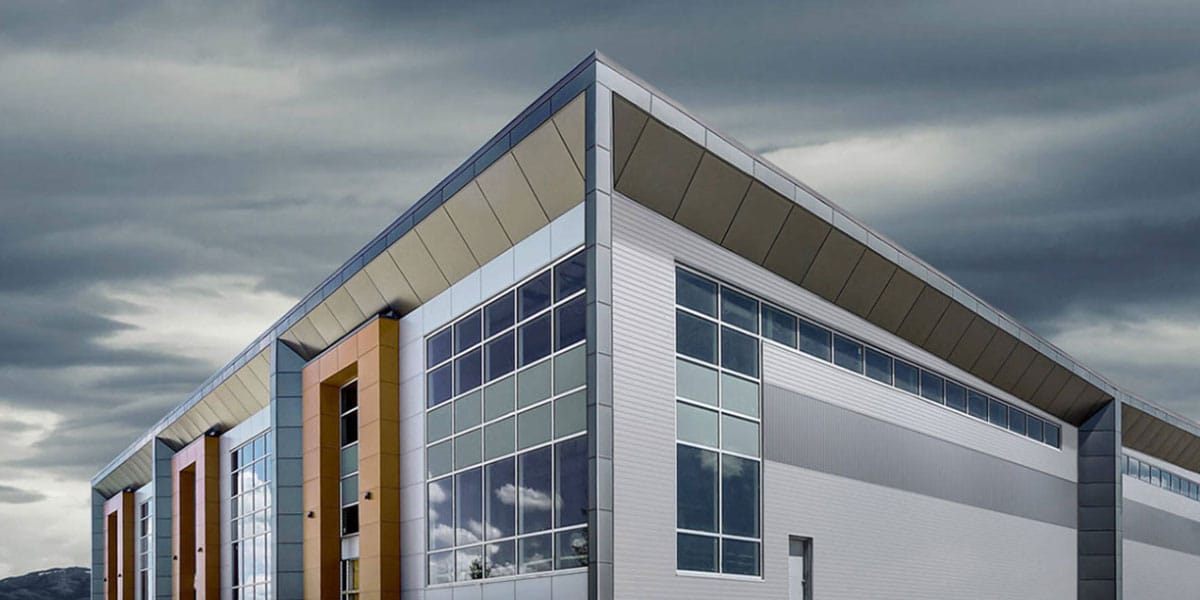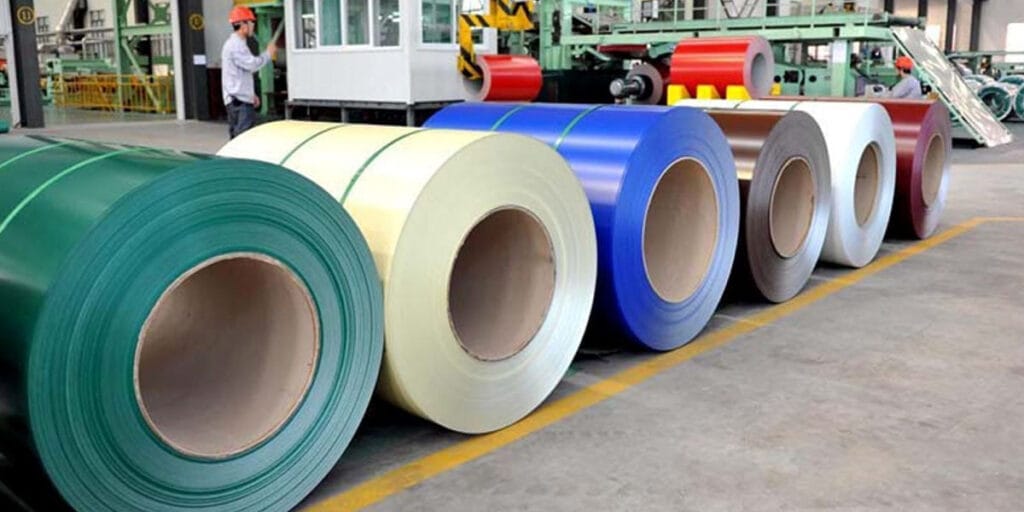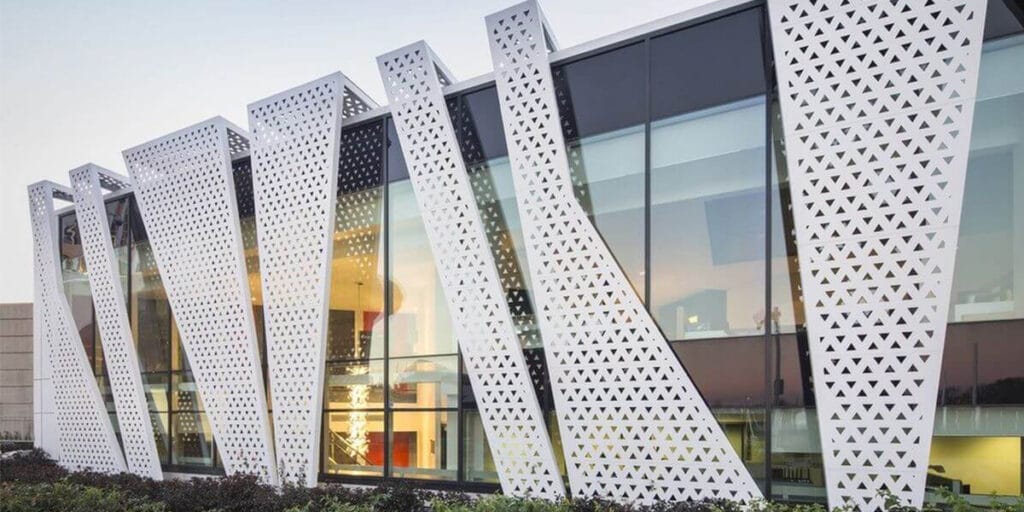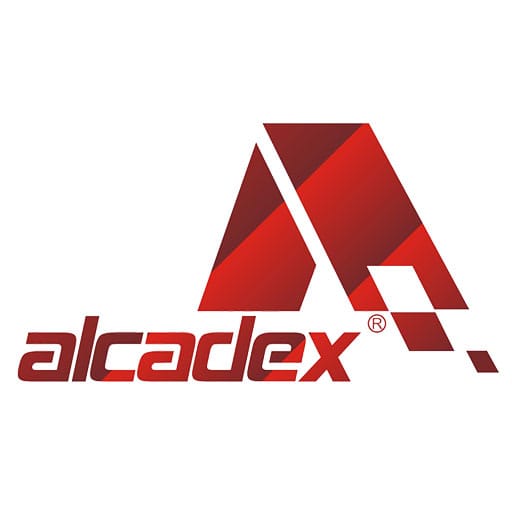
27 Feb What Are Aluminum Composite Panels Made Of
Table of Contents
Aluminum composite panels, or what are aluminium composite panels, are multi-layered materials designed for strength and versatility. They consist of two thin aluminum sheets bonded to a core material, creating a lightweight yet durable structure. These panels are essential in industries like construction, automotive, and signage.
- In construction, aluminum composite panels provide durability and aesthetic appeal for facades and interiors.
- The automotive industry uses them for vehicle parts like roofs and doors, ensuring strength without adding unnecessary weight.
- Their recyclability and energy-efficient properties make them a sustainable choice for modern applications.
Rapid urbanization and the push for eco-friendly materials continue to drive their demand globally.
What Are Aluminum Composite Panels?
Definition and Structure
Aluminum composite panels, also known as ACPs, are innovative building materials designed for strength, durability, and versatility. They consist of two thin aluminum sheets bonded to a non-metallic core. This core, often made from thermoplastic binders or mineral fillers, plays a crucial role in providing stability and strength. The aluminum layers are typically painted or coated, enhancing their appearance and resistance to environmental factors.
The structure of an aluminum composite panel is a result of advanced manufacturing techniques. The core material is coextruded and bonded to the aluminum sheets using specialized adhesives. This process ensures a seamless connection between the layers, creating a lightweight yet robust material. The combination of these components makes ACPs a preferred choice for various applications, from construction to industrial design.
Key Features and Characteristics
Aluminum composite panels offer several advantages that set them apart from traditional materials. Their lightweight construction makes them easy to handle, transport, and install. Despite their low weight, they maintain excellent strength and durability. You can rely on them to resist warping, cracking, and degrading, even in extreme temperatures ranging from -50°C to +80°C.
These panels also provide exceptional weather resistance. They withstand UV radiation, impact, and harsh environmental conditions without losing their structural integrity. Fire-resistant options, featuring mineral-filled cores, meet international safety standards, making them suitable for high-rise buildings. Additionally, the core material offers sound and thermal insulation, improving energy efficiency and noise control in buildings.
| Advantage | Description |
|---|---|
| Lightweight Construction | Easier to handle, transport, and install compared to heavier materials like concrete or solid metal sheets. |
| Fire-Resistant Options | Fire-rated ACPs with mineral-filled cores meet international fire safety regulations. |
| Sound and Thermal Insulation | The core material provides thermal insulation and soundproofing properties. |
The aesthetic versatility of aluminum composite panels is another key feature. They come in a wide range of colors, textures, and finishes, allowing you to achieve the desired look for your project. Whether you need a sleek metallic finish or a vibrant color, ACPs can meet your design needs while maintaining functionality.

What Materials Are Used in Aluminum Composite Panels?
Aluminum Layers
The aluminum layers in aluminum composite panels play a critical role in their strength and durability. These layers are made from high-quality aluminum alloys, which provide excellent mechanical properties and resistance to environmental factors. Depending on the application, manufacturers use different aluminum alloy series to meet specific requirements.
| Aluminum Alloy Series | Main Alloy | Key Properties |
|---|---|---|
| 3000 series (3005/3015) | Manganese | Better mechanical properties, higher ultimate load and yield strength, better machinability. |
| 5000 series (5005) | Magnesium | Excellent resistance to atmospheric corrosion, increased hardness, better finish for surface treatments. |
These alloys ensure that the aluminum composite material remains lightweight yet strong, making it suitable for various applications.
Core Material Options
The core material is the central layer of an aluminium composite panel, providing stability and additional properties like insulation. Most panels use polyethylene (PE) cores, which are lightweight and offer excellent thermal and acoustic insulation. However, for applications requiring fire safety, fire-resistant (FR) cores are preferred. These cores contain mineral fillers that enhance fire resistance while maintaining the panel’s lightweight structure.
- Polyethylene (PE) Core: Lightweight but combustible, ideal for interior cladding or non-fire-critical applications.
- Fire-Resistant (FR) Core: Mineral-filled core designed to meet fire safety standards, perfect for high-rise buildings and exterior cladding.
This variety in core materials allows you to choose the right panel for your specific needs, whether it’s for safety, insulation, or cost-effectiveness.
Coatings and Finishes
The coatings and finishes applied to aluminium composite panels enhance their appearance and functionality. These finishes protect the panels from environmental damage and offer a wide range of aesthetic options. Here are some common types of coatings and their benefits:
| Type of Coating/Finish | Purpose and Benefits |
|---|---|
| PVDF Coated Aluminum Composite Panels | Exceptional weather resistance, durability, and a wide range of colors and finishes. |
| PE Coated Aluminum Composite Panels | Cost-effective, vibrant colors, suitable for limited external exposure. |
| Nano Self-Cleaning Aluminum Composite Panels | Hydrophobic effect that repels dirt and water, ideal for urban environments. |
| Brushed Aluminum Composite Panels | Distinctive aesthetic with a textured appearance, adds sophistication to modern designs. |
| Wooden Finish Aluminum Composite Panels | Mimics wood’s beauty while providing durability and low maintenance. |
| Mirrored Aluminum Composite Panels | Reflective surface creates dynamic visual effects, enhancing modern architectural designs. |
| Printed Aluminum Composite Panels | Customizable with high-resolution prints for unique designs, often used for branding and signage. |
These finishes not only improve the panel’s durability but also allow you to achieve the desired look for your project, whether it’s a sleek modern design or a natural wood-like appearance.
How Is Aluminum Composite Material Structured?
Layered Composition
Aluminum composite panels consist of multiple layers that work together to create a strong and versatile material. The outer layers are made of aluminum sheets, which provide durability and resistance to environmental factors. These sheets are bonded to a core material, often polyethylene or a mineral-filled fire-resistant core. This layered structure ensures the panels remain lightweight while offering excellent strength and stability. The combination of materials makes aluminum composite panels suitable for a wide range of applications, from building facades to signage.
Bonding Process
The bonding process is a critical step in manufacturing aluminum composite panels. It ensures the layers adhere firmly to each other, creating a durable and reliable product. Manufacturers use methods like 3MVHB tape or all-purpose adhesive to bond the aluminum sheets to the core material. These techniques provide strong adhesion, which is essential for maintaining the structural integrity of the panels. Proper bonding also enhances the panels’ resistance to environmental factors, such as moisture and temperature changes. When you choose aluminum composite panels, you can trust their durability and long-lasting performance.
Thickness and Customization
The thickness of aluminum composite panels varies depending on their intended use. For exterior wall decoration or advertising signs, the aluminum sheets typically have a minimum thickness of 0.2mm, with a total panel thickness of at least 4mm. Indoor panels are thinner, with aluminum sheets starting at 0.1mm and a total thickness of around 3mm. Building curtain wall panels require thicker aluminum sheets, starting at 0.5mm, with a total thickness exceeding 4mm.
| Application Type | Minimum Thickness of Aluminum Sheets | Total Thickness Range |
|---|---|---|
| Exterior Wall Decoration/Advertising Signs | 0.2mm (minimum) | ≥ 4mm |
| Indoor Aluminum Composite Panels | 0.1mm (minimum) | ~ 3mm |
| Building Curtain Wall Panels | 0.5mm (minimum) | > 4mm |
Customization options allow you to select the right thickness and finish for your project. Whether you need panels for indoor use or high-rise buildings, you can find a solution tailored to your requirements.
Key Properties of Aluminum Composite Panels
Lightweight and Strength
Aluminum composite panels are known for their lightweight construction, which offers several advantages in construction projects. You will find them easy to handle and install, reducing labor costs and saving time. Their lightweight nature also allows for modern and ambitious architectural designs without requiring heavy load-bearing walls. Despite being light, these panels maintain excellent strength, ensuring durability against harsh weather conditions.
- Aluminum composite panels simplify handling and installation.
- They reduce overall construction time and labor expenses.
- Their reduced weight supports innovative designs in construction.
This combination of lightweight and strength makes aluminum composite material an ideal choice for projects where efficiency and durability are priorities.
Weather and Corrosion Resistance
Aluminium composite panels excel in resisting weather and corrosion, making them suitable for outdoor applications. The aluminum layers are coated with protective finishes like PVDF or polyester, which shield the panels from UV rays and prevent color fading. These coatings also resist moisture, ensuring the panels maintain their structural integrity in challenging environments such as urban or marine settings.
| Property | Description |
|---|---|
| Protective Layer | Coatings like PVDF protect against UV rays and color fading. |
| Temperature Resistance | Aluminum layers prevent excessive expansion or contraction due to temperature changes. |
You can rely on these panels to withstand harsh elements while requiring minimal maintenance. This durability and low maintenance make them a cost-effective solution for long-term use.
Fire Resistance
Safety is a critical consideration when choosing building materials, and aluminum composite panels meet stringent fire safety standards. Panels with fire-resistant cores, such as the B1 and A2 ratings, provide enhanced protection. The B1 rating ensures the material resists flames and extinguishes quickly when the flame source is removed. The A2 rating offers superior non-combustible properties, making it ideal for fireproof construction.
These panels comply with certifications like ASTM E84, which guarantees their performance in fire-prone environments. You can trust them for high-rise buildings and other large structures where fire safety is paramount.
Aesthetic Versatility
Aluminum composite panels offer unmatched aesthetic versatility, making them a favorite choice for architects and designers. You can use these panels to achieve a wide range of visual effects, from sleek modern designs to natural textures. Their ability to mimic materials like wood, stone, or metal allows you to create stunning facades and interiors without the added weight or cost of traditional materials.
These panels come in a variety of colors, finishes, and textures. Whether you prefer a glossy, matte, or brushed finish, you will find options that suit your project. Some panels even feature printed designs, giving you the freedom to customize patterns or branding elements. This flexibility ensures that your design vision becomes a reality.
The lightweight nature of aluminum composite panels makes them easy to install on complex structures. You can use them to create curved surfaces, intricate patterns, or bold geometric shapes. Their adaptability allows you to experiment with innovative designs that stand out. Despite their lightweight construction, these panels maintain durability and structural integrity.
You will also appreciate their ability to maintain their appearance over time. The protective coatings resist fading, scratches, and environmental damage. This ensures that your project retains its aesthetic appeal for years with minimal maintenance. Whether you are designing a commercial building, a residential space, or signage, these panels provide a perfect blend of functionality and beauty.
By choosing aluminum composite panels, you gain access to a material that combines practicality with creative freedom. Their aesthetic versatility empowers you to bring your most ambitious design ideas to life.
Applications of Aluminum Composite Panels

Construction and Architecture
Aluminum composite panels have revolutionized modern architecture. You can use them for facade cladding and building envelopes to achieve a sleek, contemporary aesthetic. Their lightweight structure simplifies installation, saving both time and labor costs. These panels also provide excellent insulation, helping to regulate indoor temperatures and reduce energy consumption.
Durability is another key advantage. Aluminum composite panels withstand harsh weather conditions, including heavy rain and strong winds. This makes them ideal for high-rise buildings and structures in challenging environments. Additionally, their wide range of finishes and colors allows you to customize designs, ensuring your project stands out.
- Common Uses in Architecture:
- Facade cladding for commercial and residential buildings.
- Interior wall panels for modern aesthetics.
- Roofing and ceiling applications for lightweight durability.
Signage and Advertising
Aluminum composite panels are a popular choice for signage due to their smooth surface and ability to resist corrosion. You can rely on these panels to maintain their appearance even after prolonged exposure to UV radiation and extreme weather. Their lightweight nature makes them easy to transport and install, which is especially beneficial for large-scale advertising projects.
The smooth surface of these panels enhances the quality of printed graphics, ensuring vibrant and eye-catching designs. Whether you need signage for a storefront, billboard, or trade show, aluminum composite panels provide a durable and visually appealing solution.
- Advantages for Signage:
- Weather resistance ensures long-lasting performance.
- Lightweight construction simplifies handling and installation.
- High-quality surface supports detailed graphics and branding.
Transportation and Industrial Uses
In the transportation industry, aluminum composite panels play a crucial role in reducing vehicle weight. You can find these panels used in buses, trains, and airplanes, where their lightweight properties improve fuel efficiency and performance. Despite their lightness, they offer excellent durability, resisting wear and weathering over time.
These panels also enhance the aesthetic appeal of vehicles. Their sleek, modern appearance complements innovative transportation designs. Additionally, their versatility allows for use in both functional and decorative applications, making them a valuable material in industrial settings.
- Key Benefits in Transportation:
- Lightweight panels improve fuel efficiency.
- Durable construction withstands environmental stress.
- Aesthetic versatility enhances vehicle design.
Aluminum composite panels combine lightweight aluminum layers with a durable core, creating a versatile material for modern construction and design. You benefit from their recyclability, which supports eco-friendly practices and reduces waste. These panels also lower long-term costs through minimal maintenance, excellent insulation, and energy efficiency. Recent innovations, like fire-resistant cores and nanotechnology coatings, enhance safety and durability. Whether you need sustainable materials or customizable designs, aluminum composite panels meet diverse needs across industries. Their adaptability and performance make them indispensable in today’s architectural and industrial landscapes.


